PC-12
PC-12 on track for 2027
26 August 2025
05 November 2024
Why the Truck and Engine Manufacturers Association requested a new heavy-duty engine oil category

Work in North America on the development of the new engine oil category for heavy-duty diesel engines, known as PC-12, is well underway. In this article, Insight explores why the Truck and Engine Manufacturers Association requested the new category, the changes to emissions regulations that are on the cards and when the new category might be ready.
As the world works to improve air quality and to decarbonise, the efforts to limit tailpipe emissions from transportation is intensifying. In North America, new emissions regulations are driving changes to heavy-duty diesel vehicles. and industry lubricant specifications are evolving to ensure oils continue to offer sufficient protection and performance.
Significant efforts from the Environmental Protection Agency (EPA) and the California Air Resources Board (CARB) are underway to reduce nitrogen oxides (NOx) and greenhouse gas (GHG) emissions from heavy-duty diesel trucks. The severity of the limits for 2027 through 2032 will herald significant change to vehicle hardware, which will in turn impact lubricant requirements. These changes, along with the desire to move to lower viscosity oils for fuel economy improvement, prompted the Truck and Engine Manufacturers Association (EMA) to request a new heavy-duty diesel engine oil category development. Their request, which aims to ensure lubricants continue to deliver sufficient engine and aftertreatment protection, was accepted by the American Petroleum Institute (API) at the end of 2021.
EPA is introducing its ‘Clean Trucks Plan’ to cut NOx emissions and set updated GHG emissions standards. At the same time, CARB is introducing ultra-low NOx limits. However, the EPA NOx standards trumped the proposal by CARB for 2027, based on the aftertreatment system useful life requirement. This means all vehicles will be targeting the EPA standard of 82.5% for 2027 rather than CARB’s 90%.
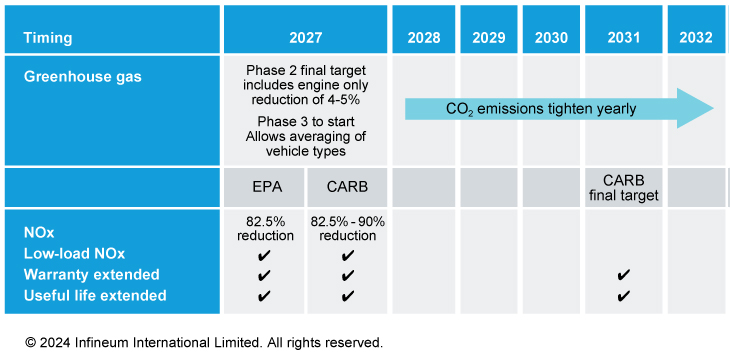
Vehicle warranty and useful life for aftertreatment equipment and emissions devices have been extended.
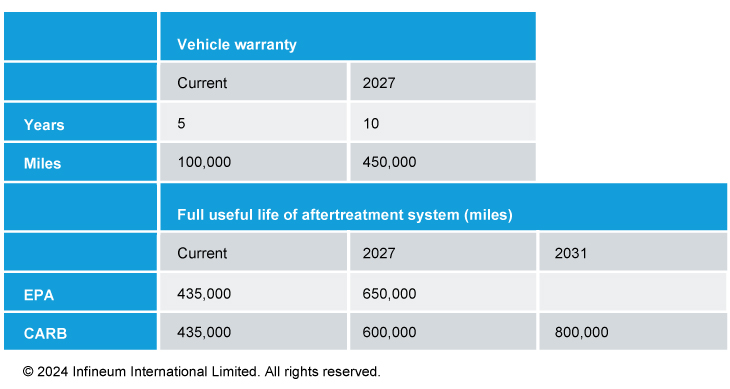
The reduction of NOx emissions will have the biggest impact on heavy-duty vehicle hardware. EPA will require a reduction from today’s 0.20 g/bhp-hr to 0.035 g/bhp-hr in NOx for on-highway type driving cycles. In addition, a new low load cycle parameter with a limit of 0.050 g/bhp-hr has been added to mimic local and stop/start type driving.
NOx emission limits are more than 80% lower than today’s, which will impact vehicle hardware.

GHG Phase 2 requirements cover model years (MY) 2021-2027 for semi-trucks, large pickup trucks, vans, and all types and sizes of buses and work trucks. EPA says combination tractors and vocational vehicles, such as delivery trucks, refuse haulers, public utility trucks, transit, shuttle and school buses, account for approximately 85% of GHG emissions in the heavy-duty truck sector. These vehicles will also be required to achieve 4-5% fuel consumption and CO2 improvement over MY 2017 vehicles from just the engine alone.
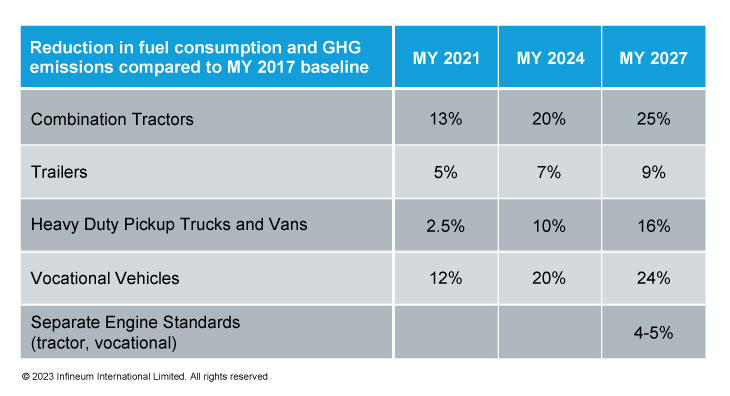
EPA says that the transportation sector is the largest US source of GHG emissions, representing 29% of total GHG emissions, with heavy-duty vehicles responsible for 25% of GHG emissions in the sector. To further reduce these emissions, in March 2024, EPA announced a final rule, Greenhouse Gas Emissions Standards for Heavy-Duty Vehicles – Phase 3.
The rule builds on the Phase 2 program, setting stronger standards to reduce these emissions from heavy-duty vehicles beginning in MY 2027. The goal of GHG Phase 3 is to hasten the transition away from diesel-powered vehicles to more efficient ones, which could include alternative power sources. Available technologies include advanced internal combustion engine vehicles (including alternate fuel sources beyond diesel, such as natural gas, propane and hydrogen), hybrid vehicles, plug-in hybrid electric vehicles, battery electric vehicles, and hydrogen fuel cell vehicles. The speed at which these new limits must be met is dependent on the type of vehicle.
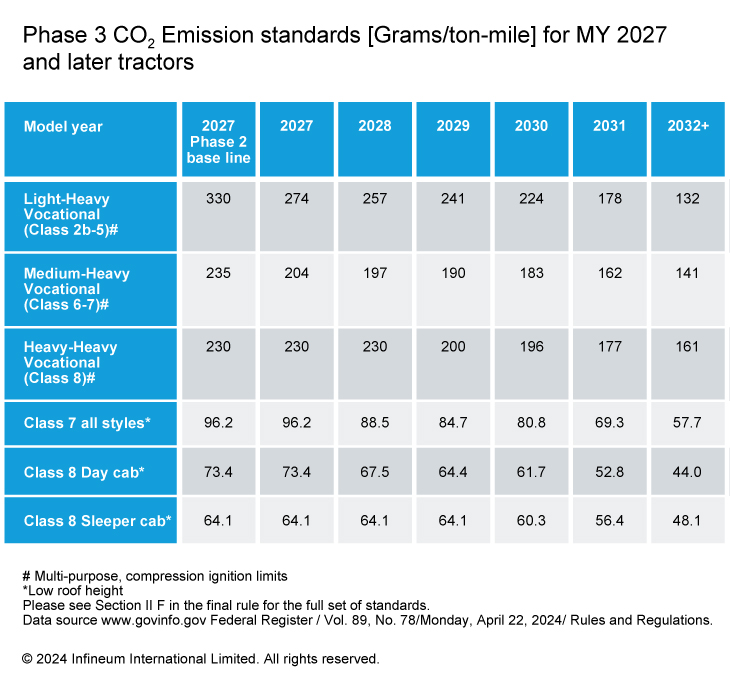
If we look at these reductions in percentage terms from 2027 to 2032 it’s more evident to see the impacts on the various vehicle types.
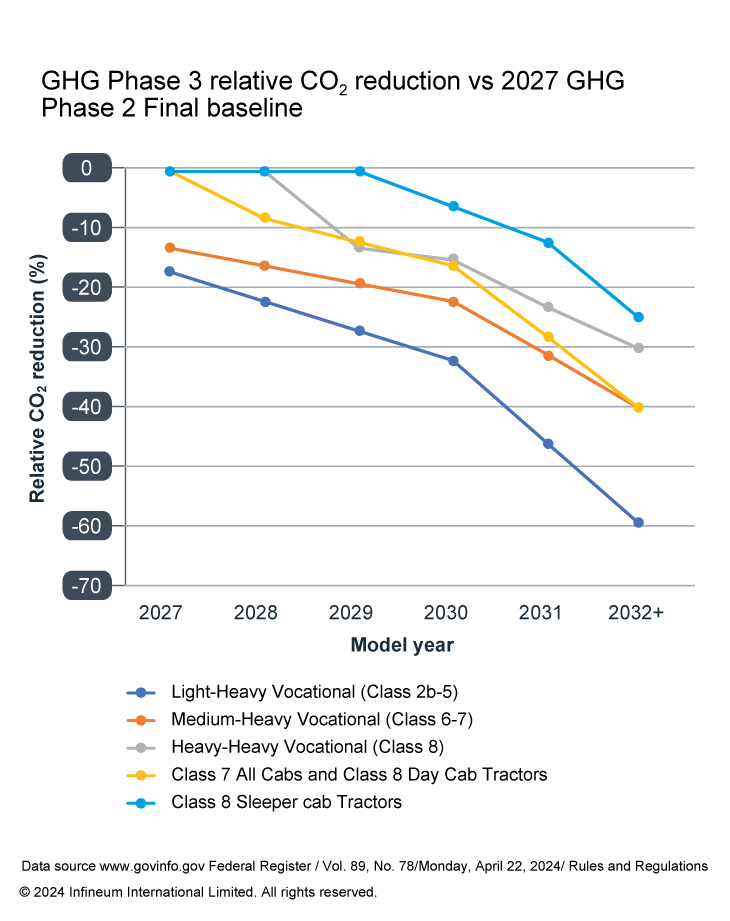
In general terms, these reduction factors, although expected to reduce CO2 emissions significantly, are in the main slightly less severe than those originally proposed for Phase 3.
EPA says the final GHG standards for heavy-duty vehicles will avoid 1 billion tons of greenhouse gas emissions - equivalent to the emissions from more than 13 million tanker trucks’ worth of gasoline. They are also expected to provide $13 billion in annualised net benefits to society related to public health, the climate, and savings for truck owners and operators. In some applications, GHG Phase 3 will help to push the roll over from conventional diesel powered ICE to alternative fuels and power sources.
To meet the emissions reduction challenges, significant advances to heavy-duty diesel engine technologies and power sources can be expected. The request for a new heavy-duty diesel engine oil category development aims to ensure lubricants continue to protect engines and aftertreatment system hardware for longer periods.
As OEMs look for fuel economy improvements, the specification will be designed to enable the use of lower viscosity grades, while still ensuring hardware protection is maintained.
Work on the new engine oil category is underway and it is expected to deliver improvements in the following areas:
In addition, we can expect the removal of obsolete tests and the introduction of new limits and new tests. The EMA is targeting a First License date of January 1 2027, ready for use in model year 2027 vehicles. There is much development and testing to be done so that engine oils are ready for market in this timeframe.
In the off-road world, CARB is already exploring potential amendments to the diesel engine standards. These Tier 5 standards can be expected to cut NOx and particulate matter emissions and may introduce first time CO2 emissions regulations for this sector. Current plans are to bring a proposal to the Board in 2025, with implementation of the Tier 5 standards expected to begin in 2029. Though not needing implementation in 2027, the expectation is that the introduction of PC-12 oils will help off-road OEMs meet their needs for Tier 5 standards to come.
Sign up here to receive our regular Insight updates to keep you up to date with PC-12 progress.
Sign up to receive monthly updates via email
